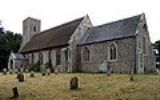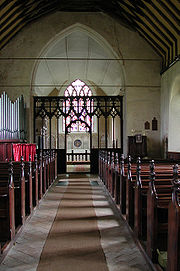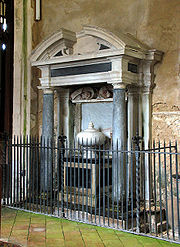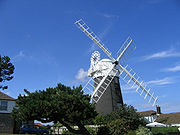
Paston, Norfolk
Encyclopedia



Civil parish
In England, a civil parish is a territorial designation and, where they are found, the lowest tier of local government below districts and counties...
in the English
England
England is a country that is part of the United Kingdom. It shares land borders with Scotland to the north and Wales to the west; the Irish Sea is to the north west, the Celtic Sea to the south west, with the North Sea to the east and the English Channel to the south separating it from continental...
county of Norfolk
Norfolk
Norfolk is a low-lying county in the East of England. It has borders with Lincolnshire to the west, Cambridgeshire to the west and southwest and Suffolk to the south. Its northern and eastern boundaries are the North Sea coast and to the north-west the county is bordered by The Wash. The county...
. The village is 4 miles (6.4 km) north-east of North Walsham
North Walsham
North Walsham is a market town and civil parish in Norfolk, England in the North Norfolk district.-Demographics:The civil parish has an area of and in the 2001 census had a population of 11,998. For the purposes of local government, the parish falls within the district of North...
and 9.1 miles (14.6 km) south-east of Cromer
Cromer
Cromer is a coastal town and civil parish in north Norfolk, England. The local government authority is North Norfolk District Council, whose headquarters is in Holt Road in the town. The town is situated 23 miles north of the county town, Norwich, and is 4 miles east of Sheringham...
. It is 19.2 miles (30.9 km) north-east of the city of Norwich
Norwich
Norwich is a city in England. It is the regional administrative centre and county town of Norfolk. During the 11th century, Norwich was the largest city in England after London, and one of the most important places in the kingdom...
. The village sits astride the coast road between Mundesley
Mundesley
Mundesley is a coastal village and a civil parish in the English county of Norfolk. The village is 20.3 miles north-north east of Norwich, 7.3 miles south east of Cromer and 136 miles north east of London. The village lies 5.6 miles north-north east of the town of North Walsham. The nearest...
and Bacton
Bacton, Norfolk
Bacton is a village and civil parish in Norfolk, England. It is on the Norfolk coast, some 20 km south-east of Cromer, 40 km north-west of Great Yarmouth and 30 km north of Norwich. Besides the village of Bacton, the parish includes the nearby settlements of Bacton Green, Broomholm,...
. The nearest railway station is at North Walsham
North Walsham railway station
North Walsham is a railway station in the town of North Walsham in the English county of Norfolk. The station is served by local services operated by National Express East Anglia on the Bittern Line from Norwich to Cromer and Sheringham...
for the Bittern Line
Bittern Line
The Bittern Line is a railway line from Norwich to Cromer then Sheringham in Norfolk, England. It is one of the most scenic in the East of England traversing the Norfolk Broads on its route to the Area of Outstanding Natural Beauty on the North Norfolk Coast. The line is part of the Network Rail...
which runs between Sheringham
Sheringham
Sheringham is a seaside town in Norfolk, England, west of Cromer.The motto of the town, granted in 1953 to the Sheringham Urban District Council, is Mare Ditat Pinusque Decorat, Latin for "The sea enriches and the pine adorns"....
, Cromer and Norwich. The nearest airport is Norwich International
Norwich International Airport
Norwich International Airport , also known as Norwich Airport, is an airport in the City of Norwich within Norfolk, England north of the city centre and on the edge of the city's suburbs....
.
History
Paston is mentioned in the Domesday BookDomesday Book
Domesday Book , now held at The National Archives, Kew, Richmond upon Thames in South West London, is the record of the great survey of much of England and parts of Wales completed in 1086...
of 1086. In the survey Paston is known by the name ‘Pastuna’ with the main tenant landowner being William de Warenne
William de Warenne
William de Warenne may refer to:*William de Warenne, 1st Earl of Surrey *William de Warenne, 2nd Earl of Surrey *William de Warenne, 3rd Earl of Surrey *William de Warenne, 5th Earl of Surrey...
. It also mentions the church and a mill in the parish. From about 1400, the village was dominated by a family called Paston. Clement Paston was a small landowner who saved enough money to have his son, William (1378–1444), educated as a lawyer and ultimately become a judge. The family went on to acquire lands throughout the county and became notably wealthy. Indeed, there is an old saying in Norfolk that 'There was never a Paston poor, a Heydon a coward or a Cornwallis a fool.' The family are remembered today mostly for their remarkable collection of private and business letters (the Paston Letters
Paston Letters
The Paston Letters are a collection of letters and papers from England, consisting of the correspondence of members of the gentry Paston family, and others connected with them, between the years 1422 and 1509, and also including some state papers and other important documents.- History of the...
) that remain from the fifteenth century. In 1597 Sir William Paston (1528–1610) moved the main family residence to Oxnead
Oxnead
Oxnead is a lost settlement in Norfolk, England, roughly three miles south-east of Aylsham. It now consists mostly of St Michael’s Church and Oxnead Hall. It was the principal residence of the Paston family from 1597 until the death of William Paston, 2nd Earl of Yarmouth in 1732...
. The last Paston of the male line, the 2nd Earl of Yarmouth
William Paston, 2nd Earl of Yarmouth
William Paston, 2nd Earl of Yarmouth was a British peer and politician.Born in 1654, he was the son of Robert Paston, 1st Earl of Yarmouth and his wife, Rebecca, née Clayton. In 1671, he married the widowed Charlotte Howard, née FitzRoy , the illegitimate daughter of Charles II and Elizabeth...
, died in 1732. The Paston estate was then acquired by Lord Anson, passing in the early nineteenth century to the Mack family. The village was served by Paston & Knapton railway station
Paston & Knapton railway station
Paston and Knapton railway station was a station in North Norfolk on the Norfolk and Suffolk Joint Railway line between Cromer Beach and North Walsham. It served the settlements of Paston & Knapton, through it was nearer to the former. It closed on 5 October 1964 to passengers and to goods on 28...
on the North Walsham to Cromer section of the Norfolk and Suffolk Joint Railway
Norfolk and Suffolk Joint Railway
The Norfolk and Suffolk Joint Railway was a British joint railway company.The NSJR was owned by the Great Eastern Railway and the Midland and Great Northern Joint Railway and consisted of two distinct sections: a line between North Walsham and Cromer via Mundesley, and a coastal section running...
from 1881 until 1964.
The parish church of Saint Margaret
The church dates from the 14th century and is constructed from flint. English HeritageEnglish Heritage
English Heritage . is an executive non-departmental public body of the British Government sponsored by the Department for Culture, Media and Sport...
has given it Grade I listed building status. It has an embattled tower which looks down on a thatched roof. The porch is on the south elevation and opens to a plain nave
Nave
In Romanesque and Gothic Christian abbey, cathedral basilica and church architecture, the nave is the central approach to the high altar, the main body of the church. "Nave" was probably suggested by the keel shape of its vaulting...
and chancel
Chancel
In church architecture, the chancel is the space around the altar in the sanctuary at the liturgical east end of a traditional Christian church building...
which is divided by an originally 15th century rood screen
Rood screen
The rood screen is a common feature in late medieval church architecture. It is typically an ornate partition between the chancel and nave, of more or less open tracery constructed of wood, stone, or wrought iron...
. The church was restored in 1601, 1843 and again in 1869. In 1922 wall paintings were uncovered. One is of Saint Christopher
Saint Christopher
.Saint Christopher is a saint venerated by Roman Catholics and Orthodox Christians, listed as a martyr killed in the reign of the 3rd century Roman Emperor Decius or alternatively under the Roman Emperor Maximinus II Dacian...
carrying the Christ child. Another depicts the legend of the three kings
Danse Macabre
Dance of Death, also variously called Danse Macabre , Danza de la Muerte , Dansa de la Mort , Danza Macabra , Dança da Morte , Totentanz , Dodendans , is an artistic genre of late-medieval allegory on the universality of death: no matter one's...
who, when hunting merrily in the forest, suddenly encountered three hanging skeletons. There is also a small figure from a 'Weighing of souls
Weighing of souls
The psychostasia, Greek 'weighing of souls', is a method of divine determination of fate, which persists from the Iliad through to christian theology....
' and the remains of some post-Reformation texts.
The Paston Monuments are at the eastern end of the building. The tomb of Katherine Knevet (the wife of Sir Edmund Paston) who died in 1628 stands on the north side of the chancel. This was created by Nicholas Stone
Nicholas Stone
Nicholas Stone was an English sculptor and architect. In 1619 he was appointed master-mason to James I, and in 1626 to Charles I....
, the master-mason to King Charles I
Charles I of England
Charles I was King of England, King of Scotland, and King of Ireland from 27 March 1625 until his execution in 1649. Charles engaged in a struggle for power with the Parliament of England, attempting to obtain royal revenue whilst Parliament sought to curb his Royal prerogative which Charles...
, who was frequently employed by the Paston family, and contains a verse epitaph written by the famous 'metaphysical'
Metaphysical poets
The metaphysical poets is a term coined by the poet and critic Samuel Johnson to describe a loose group of British lyric poets of the 17th century, who shared an interest in metaphysical concerns and a common way of investigating them, and whose work was characterized by inventiveness of metaphor...
poet John Donne
John Donne
John Donne 31 March 1631), English poet, satirist, lawyer, and priest, is now considered the preeminent representative of the metaphysical poets. His works are notable for their strong and sensual style and include sonnets, love poetry, religious poems, Latin translations, epigrams, elegies, songs,...
who was Dean of St Paul's
Dean of St Paul's
The Dean of St Paul's is the head of the Chapter of St Paul's Cathedral in London, England in the Church of England. The most recent Dean, Graeme Knowles, formerly Bishop of Sodor and Man, was installed on 1 October 2007 and resigned on 31 October 2011...
Cathedral, London. The tomb is made of alabaster and pink-veined marble and shows a semi-reclining Lady Katherine, sculpted in white marble, surrounded by numerous allegorical figures. Stone also composed the neighbouring tomb of Sir Edmund who died in 1632. This has a plain urn on a bare base in an aedicule of black Doric columns. Pevsner comments that the 'contrast between the severity of the one and the ebullience of the other is startling'. The chancel also contains three tomb-chests. The one at the eastern end is believed to be that of John Paston, who died in 1466 and was originally buried in Bromholm Priory
Bromholm Priory
Bromholm Priory was a Cluniac priory, situated in a coastal location near the village of Bacton, Norfolk, EnglandBromholm Priory, also known as Bacton Abbey, was founded in 1113 by William de Glanville, Lord of Bacton, and was originally subordinate to Castle Acre Priory until 1195 when it was...
in a magnificent funeral involving forty barrels of beer and ale.
There are some stained glass
Stained glass
The term stained glass can refer to coloured glass as a material or to works produced from it. Throughout its thousand-year history, the term has been applied almost exclusively to the windows of churches and other significant buildings...
windows that are in memory of members of the Mack family alongside memorial plaques within the nave. The east window is in memory of John Mack of Paston Hall, who died in 1867, and is attributed to the firm of Clayton and Bell. The south window next to the rood loft doorway is dedicated to Lt Cdr Ralph Michael Mack RN
Royal Navy
The Royal Navy is the naval warfare service branch of the British Armed Forces. Founded in the 16th century, it is the oldest service branch and is known as the Senior Service...
who went down with his ship, HMS Tornado, off the Dutch coast in 1917.
The Paston Family
The village is probably best known for its association with the Paston family, who made their home in an earlier building on the site of the present Paston Hall. The family is most noted for the Paston Letters, a collection of letters and papers, consisting of the correspondence of members of the family, and others connected with them, between 1422 and 1509, and including some state papers and other important documents. Most of the Paston letters and associated documents are now in the British MuseumBritish Museum
The British Museum is a museum of human history and culture in London. Its collections, which number more than seven million objects, are amongst the largest and most comprehensive in the world and originate from all continents, illustrating and documenting the story of human culture from its...
, but a few are in the Bodleian Library
Bodleian Library
The Bodleian Library , the main research library of the University of Oxford, is one of the oldest libraries in Europe, and in Britain is second in size only to the British Library...
, Oxford, at Magdalen College, Oxford
Magdalen College, Oxford
Magdalen College is one of the constituent colleges of the University of Oxford in England. As of 2006 the college had an estimated financial endowment of £153 million. Magdalen is currently top of the Norrington Table after over half of its 2010 finalists received first-class degrees, a record...
, and at Pembroke College, Cambridge
Pembroke College, Cambridge
Pembroke College is a constituent college of the University of Cambridge, England.The college has over seven hundred students and fellows, and is the third oldest college of the university. Physically, it is one of the university's larger colleges, with buildings from almost every century since its...
.
In a letter dated 4 February 1445, Agnes Paston, the widow of William Paston, advised her son Edmond (1425–49) 'to think once of the day of your father's advice to learn the law; for he said many times that whosoever should dwell at Paston should have need to con defend himself'. The letter goes on to list several disputes with neighbours. One of these was with the vicar of Paston over William's diversion of a highway from the south to the north side of the Paston family house and therefore of the church. This perhaps helps to explain why today the lychgate at Paston stands on a small path to Paston Hall rather than on the road to the north. The dispute rumbled on for some years and about 1451 Agnes wrote to another son, John (1421–66) to tell him how an argument broke out on the subject after evensong on the Sunday before St Edmund's Day (ie, in mid November). She was in the church when one Clement Spicer came up to her and demanded to know why she had closed the King's way. A Warren Harman, who had been leaning over the parclose and listening, then intervened, condemning the 'ruely change' and saying the 'town' was £100 worse off as a result. Agnes told him to mind his own business but he followed her out into the churchyard and said that he would have 20 nobles off her for closing the road and would open it again. Agnes warned that he would have to pay for his actions if he did. The row then moved on to whether Agnes had taken too much hay from land she rented to Harman at North Walsham. Bidding her to take no more than four acres, he strode off.
Life in Paston at this time was dangerous because of raids from the sea by French sailors. Agnes, in another letter to John dated 11 March 1450 and written in Norwich, reports that Richard Lynsted had been to see her from Paston that day and had let her know that Warren Harman's half-brother had been 'taken with enemies' while walking along the sea side. Two pilgrims, a man and a woman, had also been attacked. The woman was robbed but allowed to go. The man was led down to the sea but when he managed to convince the raiders that he was indeed a pilgrim, they gave him money and put him back on land. Agnes also mentions that the pirates 'have thys weke takyn iiij vessellys of Wyntyrton and Happysborough, and Ecles men been sore aferd for takyn of mo, for there ben x grete vessellys of the enemyis' (the numerals are Roman, signifying four and ten ships).
Paston Hall
The original Paston Hall was built by William Paston (1378–1444) in the fifteenth century. This building was partly destroyed by fire during the reign of King Henry VIII and was replaced by a ‘great rose-coloured mansion’ that appears in a portrait of Sir William Paston (1528–1610). According to Blomefield’s History of Norfolk, published between 1739 and 1775, this Hall had two courts with the inner one containing a well. Blomefield reported that the great hall was still standing but the chambers and chapel were in ruins. The arms of the Berry family could be seen carved over a door, recalling the marriage of William Paston to Agnes Berry in 1420.In the eighteenth century, Lord Anson, who acquired the estate from the impecunious William Paston, 2nd Earl of Yarmouth, built a new house on the site. The remnants of the old house were left standing. An account written in 1796 says that the ruins stood at the east side of the courtyard with new domestic rooms on the north and south sides and a turreted gateway on the west. The gateway was described as being built of flint with quoins of freestone, with extensive cellars. A print of 1823 shows several polygonal chambers and excavations carried out in 1900 revealed the foundations of a hexagonal chamber. In 1824, John Mack acquired the estate and built the present Hall, incorporating parts of the Anson house and the Tudor cellars.
At various times, Paston Hall has been surrounded by outhouses, shrubberies, orchards and lawns. To the south east is a small field known as the ‘Duffus’, which was the site of a medieval dovecote reached by a path along a double hawthorn hedge.
Paston Great Tithe Barn
The tithe barn was built by Sir William Paston (1528–1610), the founder of the Paston Grammar SchoolPaston College
thumb|right|Sketch of the original Paston buildingPaston Sixth Form College is a sixth form college in North Walsham, Norfolk, England, United Kingdom....
in North Walsham
North Walsham
North Walsham is a market town and civil parish in Norfolk, England in the North Norfolk district.-Demographics:The civil parish has an area of and in the 2001 census had a population of 11,998. For the purposes of local government, the parish falls within the district of North...
, in 1581 and was used to store and thresh corn. The barn is constructed of flint and brick with an alternate tie and hammerbeam roof, which is thatched. The barn is 160 feet (48.8 m) long and 24 feet (7.3 m) wide; to the apex the height is 60 feet (18.3 m). It has Grade II* listed building status. Pevsner remarks that the roof span does not require hammer beams and that 'they are here for show: the Renaissance magnate's love of bravado and expression of wealth'.
Stow Mill
Just on the Paston side of the boundary with MundesleyMundesley
Mundesley is a coastal village and a civil parish in the English county of Norfolk. The village is 20.3 miles north-north east of Norwich, 7.3 miles south east of Cromer and 136 miles north east of London. The village lies 5.6 miles north-north east of the town of North Walsham. The nearest...
stands Stow Mill. This is a tarred brick tower windmill built between 1825 and 1827 by James Gaze. The mill operated as a flour mill between 1828 and 1930 and is now restored and open to visitors. The mill is a Grade II listed building.
See also
- Paston LettersPaston LettersThe Paston Letters are a collection of letters and papers from England, consisting of the correspondence of members of the gentry Paston family, and others connected with them, between the years 1422 and 1509, and also including some state papers and other important documents.- History of the...
- Paston Great BarnPaston Great BarnPaston Great Barn is a mediaeval barn, near Paston Hall on the southeast edge of the village of Paston, in northeast Norfolk, England. It is owned by the North Norfolk Historic Buildings Trust. It dates from 1581 and is associated with the Paston family...
- Robert Paston, 1st Earl of YarmouthRobert Paston, 1st Earl of YarmouthRobert Paston, 1st Earl of Yarmouth, FRS was an English politician, nobleman and scientist. The Paston family had a long history. His father William , was created a baronet in 1642, and on his death was succeeded in the title by Robert. Robert was subsequently created a Viscount and then became an...
- William Paston, 2nd Earl of YarmouthWilliam Paston, 2nd Earl of YarmouthWilliam Paston, 2nd Earl of Yarmouth was a British peer and politician.Born in 1654, he was the son of Robert Paston, 1st Earl of Yarmouth and his wife, Rebecca, née Clayton. In 1671, he married the widowed Charlotte Howard, née FitzRoy , the illegitimate daughter of Charles II and Elizabeth...
- Paston & Knapton railway stationPaston & Knapton railway stationPaston and Knapton railway station was a station in North Norfolk on the Norfolk and Suffolk Joint Railway line between Cromer Beach and North Walsham. It served the settlements of Paston & Knapton, through it was nearer to the former. It closed on 5 October 1964 to passengers and to goods on 28...
- Bromholm PrioryBromholm PrioryBromholm Priory was a Cluniac priory, situated in a coastal location near the village of Bacton, Norfolk, EnglandBromholm Priory, also known as Bacton Abbey, was founded in 1113 by William de Glanville, Lord of Bacton, and was originally subordinate to Castle Acre Priory until 1195 when it was...
- Bacton Gas TerminalBacton Gas TerminalThe Bacton Gas Terminal is a large gas terminal found on the North Sea coast in North Norfolk near Paston and between Bacton and Mundesley. The nearest main town is North Walsham. The other main UK gas terminals are at St Fergus, Aberdeenshire and the Easington, East Riding of...
- OxneadOxneadOxnead is a lost settlement in Norfolk, England, roughly three miles south-east of Aylsham. It now consists mostly of St Michael’s Church and Oxnead Hall. It was the principal residence of the Paston family from 1597 until the death of William Paston, 2nd Earl of Yarmouth in 1732...

